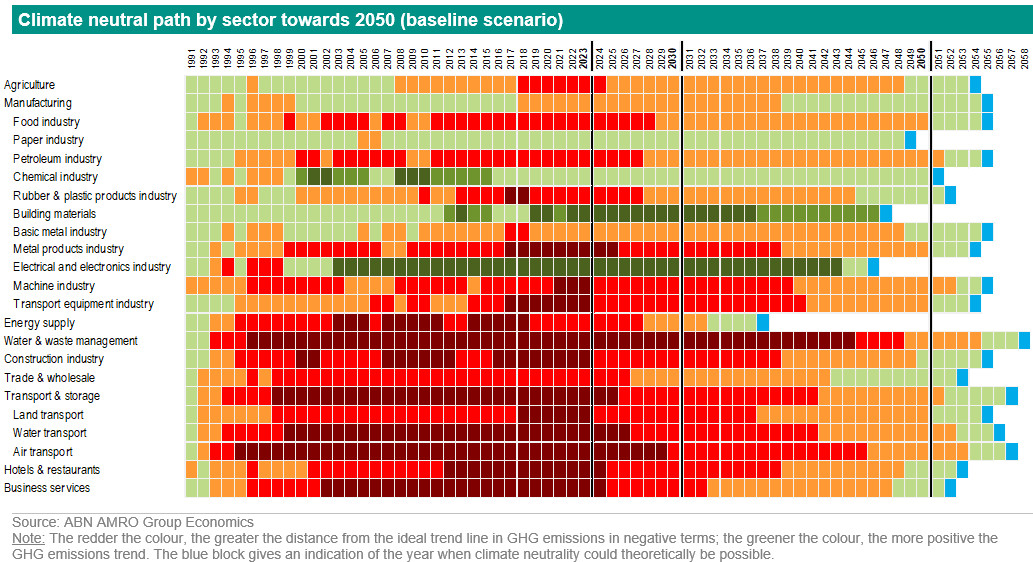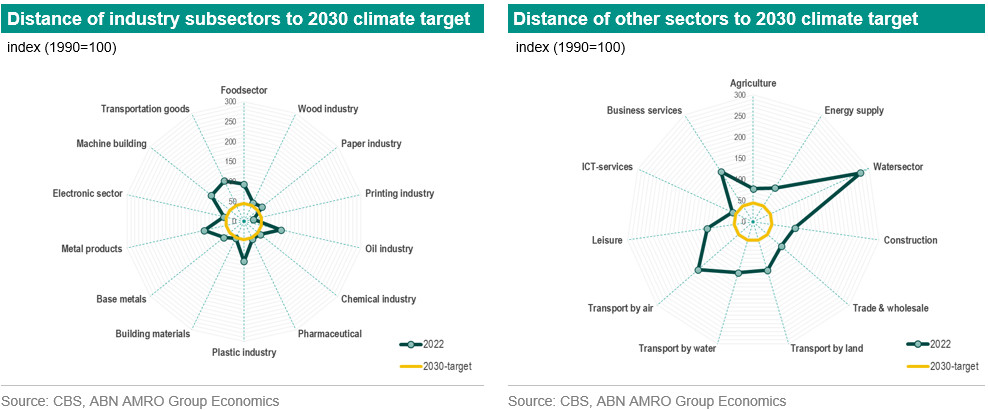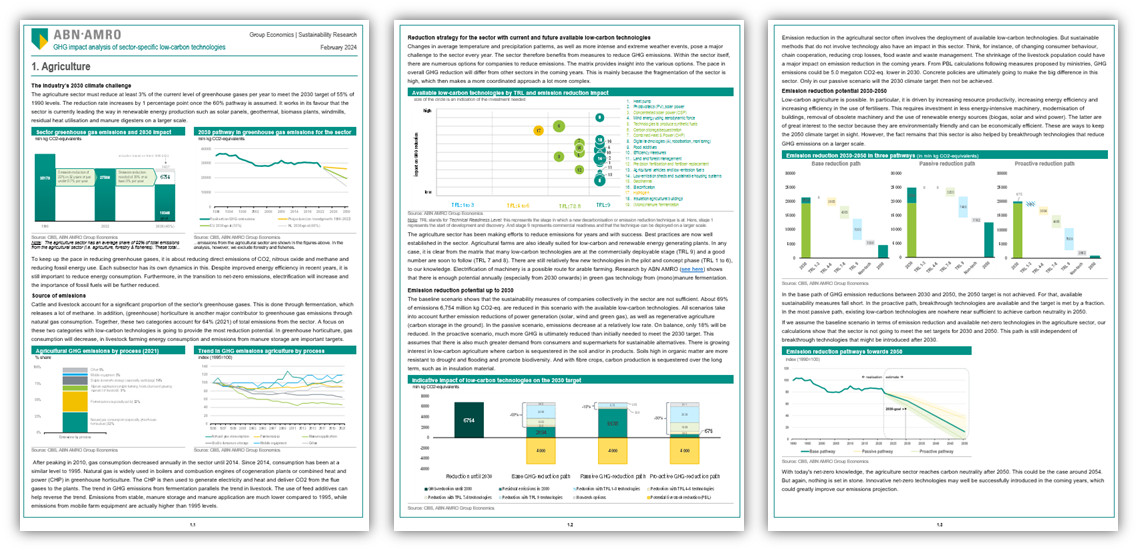ESG Economist - 2030 climate target within reach for many Dutch sectors

In this publication, we answer the question of what the path of the Dutch economy and its sectors towards the ultimate 2050 climate-neutral goal might look like. In particular, we look here at the impact that low-carbon technologies can have on reducing greenhouse gases for 21 sectors in our so-called Sector Technology Pathways. What sectors are the heavyweights in the transition, where is reducing greenhouse gases most challenging and what are bottlenecks we need to overcome in the transition?
We look at the emission reduction potential of current and future decarbonisation technologies for sectors of the Dutch economy to 2030 and then towards 2050
In this publication, we focus on low carbon technologies in 21 sectors and outline our emission reduction scenarios by sector
For each of the 21 sectors – capturing more than 75% of all emissions – we build three emission scenarios: a base case and a passive and proactive pathways
We use technological readiness indicators in order to identify the technologies that are ready to use and then estimate their emission-reduction potential for each sector
Important low carbon technologies are energy efficiency measures, electrification, production of renewable energy, raw material substitution and building insulation
With available decarbonisation technologies, the 2030 target could potentially be in reach if companies and sectors are proactive in implementing the available technologies
However, in our base case, which assumes a less proactive approach and the existence of various bottlenecks, a large number of sectors would fall short
Bottlenecks include the availability of qualified personnel and critical materials, but also the costs and availability of finance for the transition
In highly energy-intensive Dutch industries, such as food, petroleum and basic metals, the challenge is still relatively high
In transport sectors and in water & waste management, the number of radical low-carbon technologies is less or the terms and requirements are less available for the technology to break through or public policy is less stringent or transparent
The success of climate measures taken in the short term – until 2030 – is going to determine largely the path to 2050
Our analysis shows that companies in many sectors often have ample opportunities to reduce their GHG emissions. Sometimes these are the 'low-hanging fruit' and relatively easy to implement. However often they are also complex adjustments in processes. Decarbonisation is thus always tailor-made. We start this publication with an introduction to our framework and scenarios, after which we dive deeper into the main conclusion. Finally we present the sector deep dives for 21 sectors of the Dutch economy and the low carbon impact going forward.
Distance to climate targets in sectors
Many sectors have enough low-carbon technologies to achieve substantial GHG emission reductions between now and 2030. However, despite the current widespread availability of the technologies, breakthrough technologies often remain to be found. These breakthrough technologies should help clear the path between 2030 and 2050. Our analysis shows - based on the baseline scenario - that a majority of sectors in the Dutch economy may not reach the climate-neutral target. For that, the challenges and obstacles mentioned earlier are too great. However, some sectors come close to the 2050 target and about four are capable of achieving climate neutrality before 2050. The vanguards are the paper industry, the building materials industry, the electrical industry and the electricity sectors.

In the goal of achieving climate neutrality by 2050 for the entire Dutch economy, the electricity sector has a leading role. After all, it is relatively easier to decarbonise the electricity sector than to phase out all fossil fuels in other sectors. The Climate Fund takes this into account. By subsidising this sector with the construction of new nuclear and low-carbon gas-fired power plants (including carbon capture and storage (CCS)), GHG emission reductions can be achieved sooner.
Distance to 2030 climate target
With current GHG emission reduction technologies, the 2030 climate targets are within reach for Dutch industry. This is a different story in other sectors, such as transport or water & waste management. This is apparent from the figure above, where these sectors haven a dark red indication, which signals that the distance and deviation from the trend line is still very far. There, the number of radical technologies to reduce GHGs is lower or the resources are not available for the technology to break through. For instance, electrification in the transport sector is the holy grail for a climate-neutral future, but its penetration is insufficient so far to meet the set 2030 target.
The following two figures each have the same starting point. They show the distance of the different sectors to the 2030 target. For simplicity and comparability, we have set it here at 55% of the 1990 GHG emission level (the EU target) for all sectors. There are of course sectors with different climate ambitions towards 2030. The two figures also have identical axes to further enhance comparability. The left figure shows industry and its subsectors, while the right figure shows the other Dutch sectors. It is immediately noticeable that the 2030 target for industry and its subsectors is not an unbridgeable gap. Some industrial subsectors are still relatively behind, but the stronger reduction in GHG emissions is achievable with available decarbonisation technologies. In the non-industrial sectors (right figure), the distance to the 2030 target is still challenging, especially for the transport sector and water and waste management.

For now, business investment in low-carbon industrial technologies remains a prerequisite for achieving GHG emission reduction targets. Government policies are going to help drive those investments in the coming years. To cost-effectively reduce GHG emissions from large companies within sectors, the EU has emissions trading (EU ETS) at its disposal as a policy measure. This is a powerful tool. Within this trading instrument - which trades emission allowances that give the right to emit a certain amount of GHGs - an ever-decreasing cap of allowances is available. This is the total allowable CO2 emissions. The level of the emissions cap is adjusted as the EU updates its targets. This ceiling will gradually go down in the future, reducing the number of available allowances over time. If sectors do not make sustainability improvements in time, the number of allowances will become increasingly scarce, increasing the price of CO2. This will incentivise companies to invest more in GHG emission reductions, ultimately reducing overall emissions. Towards 2030, many sectors covered by the EU ETS face a faster decline in the number of emission-free allowances. Some sectors already face a sharp reduction in this before 2030, but the phase-out continues after 2030 as well.
Download the publication in PDF for more analysis, such as specific low-carbon technologies for companies in sectors and obstacles in the transition towards 2050.
Sector Deep Dives
In the section with sector deep dives in the download of the publication, we focus on low carbon technologies, trends and indicators in 21 sectors. In the various scenario’s we calculate and estimate the potential impact of low carbon technologies on the GHG emissions going forward.

The following sectors are covered:
Agriculture
Food & beverage industry
Paper industry
Oil industry
Chemical industry
Rubber- & plastic products industry
Building materials industry
Base metals industry
Metal products industry
Electrical appliances & electrical industry
Machinery
Transport goods industry
Energy supply
Water companies & waste management
Construction
Retail & wholesale trade
Transport by land
Transport by water
Transport by air
Hotels & restaurants
Business services
